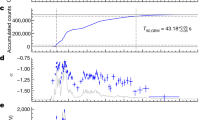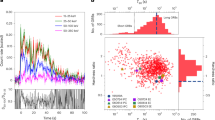Abstract
THE nature of gamma-ray-burst (GRB) sources has remained a mystery, in part because of the lack of any optical identification. Recently, deep CCD photometry has identified the optical counterpart G″ to the γ-ray source Geminga, whose location on a colour-magnitude diagram is unique1. Although the X-rays from G″ are probably due to thermal emission from the neutron star, the implied column density (≳ 5 x 1020) is inconsistent with the distance (D < 100 pc) required to fit the optical flux to the same spectral component. Here I show that the optical emission could be due instead to a cold accretion disk with accretion rate Ṁ ≈ 1011 g s−1. This has promising implications for the search for the optical counterparts to GRB sources whose basic physical parameters may resemble those of radio pulsars and related objects such as Geminga. I argue that a similar search in the field of a GRB location should produce candidates similar to G″ if 20 pc ≲ DGRB ≲ 500 pc, as predicted by the disk-reprocessing model for the associated optical transients. This possibility is discussed in the light of the fact that the first optical counterpart to a GRB source may already have been found, which, if it is confirmed, may be used to test the accretion-disk model.
This is a preview of subscription content, access via your institution
Access options
Subscribe to this journal
Receive 51 print issues and online access
$199.00 per year
only $3.90 per issue
Buy this article
- Purchase on Springer Link
- Instant access to full article PDF
Prices may be subject to local taxes which are calculated during checkout
Similar content being viewed by others
References
Halpern, J. P. & Tytler, D. Astrophys. J. 330, 201–217 (1988).
Liang, E. P. & Petrosian, V. AIP Conf. Proc. (AIP, New York, 1986).
Mazets, E. P. et al. Nature 290, 378–380 (1981).
Hueter, G. J. High Energy Transients in Astrophysics (ed. Woosley, S. E.) 373–377 (AIP, New York, 1984).
Murakami, T. et al. Nature 335, 234–235 (1988).
Melia, F. Astrophys. J. 334, L9–L12 (1988).
Melia, F. Nature 336, 658–660 (1988).
Fenimore, E. E. et al. Astrophys. J. (submitted).
Helfand, D. J. & Vrtilek, S. D. Nature 304, 41–43 (1983).
Michel, F. C. Astrophys. J. 290, 721–727 (1985).
Katz, J. I. Astrophys. Lett. 24, 183 (1985).
Ruderman, M. A. 13th Texas Symp. on Relativistic Astrophysics (ed. Ulmer, M. P.) 448–459 (World Scientific, Singapore, 1987).
Schaefer, B. E. Adv. Space Res. 6, 47 (1987).
Melia, F. Astrophys. J. 324, L21–L25 (1988).
Smith, F. G. Pulsars (Cambridge Univ. Press, 1977).
Matz, S. M. et al. Astrophys. J. 288, L37–L40 (1985).
Kouveliotou, C. Astrophys. J. 330, L101–L105 (1988).
Manchester, R. N. & Taylor, J. H. Pulsars (Freeman, San Francisco, 1977).
Melia, F. Astrophys. J. 335, 965–970 (1988).
Bignami, G. F. et al. Astrophys. J. 319, 358–361 (1987).
Romani, R. Astrophys. J. (in the press).
Michel, F. C. & Dessler, A. J. Astrophys. J. 251, 654–664 (1981).
Kafka, P. & Meyer, F. High Energy Transients in Astrophysics (ed. Woosley, S. E.) 578–580 (AIP, New York, 1984).
Epstein, R. I. Astrophys. J. 291, 822–833 (1985).
Melia, F., Rappaport, S. & Joss, P. C. Astrophys. J. 305, L51–L55 (1986).
Melia, F. Proc. Sofia COSPAR Symp. (ed. White, N.) 641–652 (1988).
Helfand, D. J. et al. Nature 283, 337–343 (1980).
Schaefer, B. E. Nature 302, 43–45 (1981).
Pedersen, H. et al. Astrophys. J. 270, L43–L47 (1983).
Schaefer, B. E. et al. Astrophys. J. 270, L49–L52 (1983).
Boer, M. et al. Astr. Astrophys. 202, 117–123 (1988).
Author information
Authors and Affiliations
Rights and permissions
About this article
Cite this article
Melia, F. Geminga and the search for optical counterparts of γ-ray-burst sources. Nature 338, 322–324 (1989). https://doi.org/10.1038/338322a0
Received:
Accepted:
Issue Date:
DOI: https://doi.org/10.1038/338322a0
Comments
By submitting a comment you agree to abide by our Terms and Community Guidelines. If you find something abusive or that does not comply with our terms or guidelines please flag it as inappropriate.



